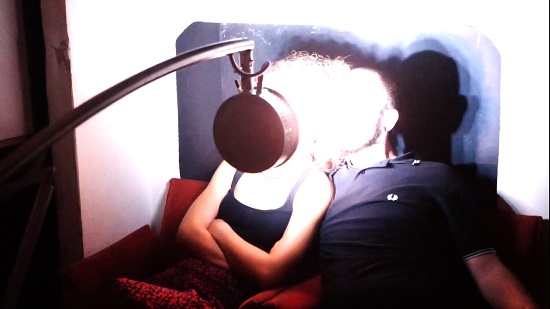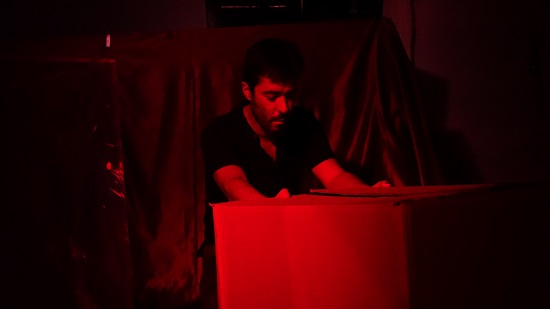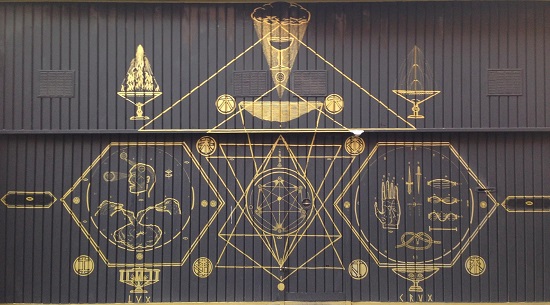Photos courtesy of Silvia Konstance Costan
In a small and smokey room, behind a garage door covered in occult symbols, on an otherwise residential street in Barcelona’s fashionable Gracia district, people queue to have their genitals stimulated by a vibrating saddle, controlled by a mystic. In the larger, smokier room next door there’s another queue, to sit in front of an intense strobe light which induces hallucinations. A few yards behind that, the mutton-chopped Victor Hurtado is halfway through one of his twice-weekly eight-hour DJ sets, blending Silver Apples with Nurse With Wound with Can with Christian hymns with black metal with afrobeat with EBM. This is Màgia Roja – ‘Red Magic’ in English – a place unlike any other in Spain, perhaps any other on earth. A members-only venue, it hosts gigs and performance art every Friday and Saturday and then morphs into a club night; by about 3 or 4 in the morning the tight space is most often full, a diverse few hundred clubbers led toward frenzy by a heady mix of noise, punk, industrial, dance, rock, magick, metal and the avant garde.
The project first began to take shape when Hurtado went to San Francisco while studying a PhD in political science. The house he was staying in happened to belong to a member of The Residents. “So the second person I met in San Francisco was one of The Residents, without his mask,” he tells me through the mist of his Sunday morning hangover. “I wasn’t supposed to know, but he was wearing a Residents t-shirt. I had stopped playing music at that point, but I had an epiphany: ‘If I’m here, then it must mean something’. I had the realisation that these things are not coincidences, there’s a reason I ended up here. There was a reason because I wanted there to be a reason.”
Though a high achiever, he left his studies to play in a number of bands, the most notable being ‘Qa’a’. Unsigned, but with a sizeable following, they decided to self-release their own music, and formed the Màgia Roja label to do so. Their first and third releases, the sprawling and imposing Vesprada and Sang respectively, were named by Julian Cope as his albums of the month, and Sang as his last ever vinyl of the month. “Julian Cope reviews are great, but we didn’t do any distribution,” says Victor. “We didn’t do a very good job and it was all very chaotic, but that was the seed for a couple years later to be joined by [fellow Màgia Roja stalwarts, and married couple] Ramon [Marcet] and Pris [Querol Sans], who also wanted to put in money and release music from other bands. It didn’t move fast, it was two or three years, but eventually we became like a real label.”
For years Màgia Roja’s skeleton staff had ambitions of building a pillar of the local community, but it was not until 2014 that they finally found the space they occupy now, originally a small office occupying a fraction of the room. “It was just to do the work for the label, but then there was the opportunity that we could take over the whole building. Still we didn’t do anything for three months until the first show. We still hadn’t connected the dots.” In November that year they put on their first gig, and on New Year’s Eve put on their first party. “We thought ‘maybe we’ll have 10 or 20 people here,’ the space was smaller than now, but there were 100 people inside and 100 in the street. It was an insane party, we were dancing to all the music that we like to dance to but they never put on in clubs, music that we didn’t even know. The session was very eye-opening, we were like ‘OK, wow, we should do this more.’”
Five subsequent years of shows are memorialised in a selection of posters tacked onto the wall of what was once the foyer, above a small record-rack that has the label’s now-considerable discography up for sale among other left-field selections. They recall a night of programming in tribute to Alexander Shulgin, the legendary psychopharmacologist and so-called Godfather of Psychedelics, and the satirically-named ‘Opera’, a DJ session comprised entirely of extreme music. There have been over 400 nights here, providing the same opportunity for anyone who wishes to perform, regardless of stature. One night, Ramon tells me, through a VR installation he ‘swapped bodies’ with his eight-year-old son.

tQ is in town on a tense weekend for Catalonians. It is the Fiesta Nacional de España, the country’s national holiday in which they commemorate Christopher Columbus’ first landing in The Americas. Like Columbus Day in the United States, it stokes the divide between those who consider the explorer a genocidal tyrant, and those who do not. In the centre of Barcelona tQ sees a heated argument between a man dressed head to toe in Spanish flags and two government security guards, as well as two dozen masked and hooded young men being cordoned off and searched by as many armed policemen. Further still, the following Monday is the day of sentencing for nine Catalan separatist leaders, for their role in a failed 2017 push for independence. All over the city thousands of banners hang from elegant Gaudi balconies bearing the slogan ‘Llibertat Presos Politics’ (Freedom For Political Prisoners). When the leaders are eventually jailed for between nine and 13 years, everything suddenly snaps, leading to days of protests, reported in the media with dramatic images of burning cars, clashes with tear gas-wielding riot police, and a shutdown of the city’s airport.
Behind the garage door, Màgia Roja feels like a haven from the unease that seems to loom over the rest of the city. Not that the first night’s act is tame, of course. Guerra Fria, the solo project of the prolific Laura del Vecchio opens the show with her eyes closed in what feels like intense contemplation as she weaves a loop of remarkable noise, sometimes lurching her way into the crowd (there’s no stage at Màgia Roja) with a kind of drawling aggression. But then, a band quite pointedly called España decide to play. The alter-ego of industrial punk duo Ca de Bestiar, they hurl forth aggressive, though danceable, thuds and squalls of brain-mangling electronic noise, barking and sloganeering from a sheet of paper through heavy distortion. The Catalan flag, with España written across it in Arabic, is draped behind them. So distorted are the words that it’s hard for even the Spanish-speakers to make them out. But the message, given the context, feels obvious in its power and rage.
After Juventud Asegurada, the second part of an ongoing satirical film series about young women assaulting old men, shot with psychedelic disregard for any concept of framing while musicians Jordi Flecos and Frau Diamanda, known together as YVGVLAR, provide an ugly and enticing live soundtrack of scraping violin and feather-soft percussion, concluding with a cartoon of a penis ejaculating feces that forms the logo of producers Copro Productions, it’s time to relax. About half the crowd depart, and those that remain are served enormous sandwiches stuffed with apples, nuts, vegetables and cheese made by Ramon, who describes himself as an “experimental” chef.
Màgia Roja is a windowless room, and once dinner’s been served Viktor’s marathon DJ set, which begins shortly afterwards, becomes the best way of measuring time. He treats these sessions as an art form in their own right, spending most of his days off rehearsing for Friday and Saturday night, and is an absolute master of the craft. What becomes more and more impressive as the set goes on is how he commands the night’s momentum, wielding one single eight-hour crescendo which expands from cosmic, spiritual slowness to a wild and untethered rave without so much as a crack. It’s timed almost psychically with the evening itself, perfectly matched to an audience that at first trickles in slowly before the floodgates open around 3 in the morning, when the rest of the area’s bars close.
It’s a marathon of a Friday night, but the following afternoon the same small group of staff are gearing up for something even bigger. Saturday marks a mini-festival of sorts, a night of conceptual art called ‘La Nova Alquimia + Sessió Amor Total i Infinit’ (The New Alchemy + Total and Infinite Love Session), based around the themes of oscillations, vibrations, frequencies and light. In the venue’s back room, opened only when things get really busy, the artist Mark Wagner has set up his installation ‘33Hz Sonic Orgasm’ (the aforementioned genital vibrating saddle). He has the number 33 tattooed on his chest, a number with considerable esoteric significance, he explains as the evening gets underway. In numerology it is the most important of the three ‘master numbers’; followers of Kundalini believe divine energy to be sourced at the base of the spine’s 33 vertebrae; in The Bible Jesus is 33 when crucified, it is the number of miracles he performed in the Gospels, the number of years David ruled Jerusalem, the number of children borne by Jacob and Leah, the amount of times the word ‘Devil’ appears in the New Testament and the amount of times ‘sickness’ appears in the Old. It is also the frequency of a cat’s purr, a resting Harley Davidson, and at which a used car salesman in Daytona Beach, Florida supposedly found the answer to his quest for the ‘optimal clitoral resonance’ in 1992. Wagner has adapted this to suit all genders, ‘playing’ the saddle one-on-one for a lengthy queue of individuals in order to stimulate each of them towards orgasm.
Just outside, there’s another queue to sit two at a time in front of the hallucination-inducing strobes, while in the main room a crowd larger than yesterday’s gathers to watch a procession of staggering performance artists. Yolanda Uriz blows out a candle, and uses frequencies to toy mesmerically with the smoke projected onto the screen behind her for her performance ‘Transitory Presences #2’. Martí Guillem, meanwhile, a Màgia Roja regular and multi-instrumentalist, squats behind an array of lightbulbs, speakers, cymbals, tubes, cans, coins and balloons, linked together with a precarious tangle of wires and stacked as if assembled by a precocious child raiding a supply cupboard. Dismantling and toying with the way we connect what we see and what we hear, he makes the objects sound entirely unlike themselves using only vibrations, like a heartbeat mixed with a marching band mixed with a 1990s ringtone mixed with the take-off of a jumbo jet. It is remarkable, dizzying and terrifying.

Ramon serves dinner once again, this time curry, before the gig morphs into the party. It’s telling what a diverse crowd Màgia Roja attracts at full swing, not just in terms of age, race and sexuality, but in terms of their artistic outlook. The musicians and performers might be almost entirely esoteric, but there’s none of the exclusivity that can so often go along with that scene. A local teacher and his friend wearing a Mars Volta shirt, here for a night out, ask me earnestly to explain what ‘industrial’ music is while a dishevelled performance artist takes a nap three feet above them on a bookshelf, as a middle-aged club DJ turned truck driver from out of town wanders around amazed that he’s finally here after months of planning. “There’s always people that are converted,” says Viktor with a smile the following afternoon, as Wagner sets up his saddle for the staff to finally take their turn. “There used to be people asking me ‘why are you playing this sad music?’ but now people don’t ask that any more because they know that you come here for a different kind of experience. People hear a lot of different things. I have accustomed them with different tastes.”
Unafraid of delving wholeheartedly into the conceptual and left-field, utterly committed to art at its most uncompromising, Màgia Roja approach every minutia of what they do with utmost seriousness. That said, their philosophy was never laid out and scheduled; there was never a plan to become the ‘post-industrial Hacienda’, as they sometimes sell themselves. It was not until they discovered metamodernism when, as if by magic, they found they’d been following a path all along. “We were trying to understand, ‘why do we like this certain kind of band?’, then we read about metamodernism and we realised ‘that’s us’! That’s why this project doesn’t cut it and that one does!” Victor recalls. “Metamodernism uses the same techniques of postmodernism but the goals are modern goals: narrative, transcendence. In postmodernism there’s 1000 realities and no truth, it’s the end of art, the end of history and the end of politics, the end of everything. Metamodernism is utting narrative back in the picture. With what we release, with the sessions, with the shows, it’s important that the art object and the concept are balanced. Metamodernism is about sincerity, but postmodernism is about irony.”
There have also been some extraordinary moments of synchronicity along the way. Victor recalls one occasion when an orgy in the bathroom spilled out chaotically onto the dancefloor, and one participant knocked over a speaker stand. Once helped up, they found a record from the DJ’s collection under her back. “It’s physically impossible this record appeared on her back, and it was ‘23 Skidoo’. We attach a playful significance to the number 23, so we took out the record and it said ‘an orgy of sound’. We were like… that’s intense!” On another occasion, two transgender women called Barbara arrived on the same night, unbeknownst to each other, both of whom were filming documentaries.
For all this talk of metamodernism, sincerity and synchronicity, it might be tempting to view Màgia Roja as a little po-faced. Yet their desire to be inclusive feels like the strongest drive of all, an egalitarian philosophy that trumps all else and means that however intellectual, theoretical or conceptual their nights, they are at their core nothing more than intensely enjoyable. A sign above the entrance reads : "No means no – creeps will be expelled from Màgia Roja". The main rule, it is clear, is just to not be a dickhead.
As their reputation grows, politicians, celebrities and socialites have begun to take an interest, but in his additional role as doorman, Ramon is unflinching in his efforts to treat them all the same. When the club is full he says he’s had notable politicians try and fail to use their clout to gain access and he’s declined hundreds of euros in bribes. When local resident and Màgia Roja regular Arca brought Björk along with her for a night out, they had to pay for membership just like everyone else. The bar operates on a sliding scale depending on the customer’s financial situation, and such is the venue’s atmosphere that those better off are almost always happy to pay over the odds for a beer.

Màgia Roja shares common ground with other venues across Europe, Britain’s Café Oto, Islington Mill and New River Studios, for example; the likes of Gnod and Sly & The Family Drone have played gigs here, and collaborated with members of the Barcelona scene. Yet Victor sas they still consider themselves something of an island. There’s nowhere else he’s found that he feels quite matches them. “Maybe there’s places where they do these kinds of shows, but maybe they wouldn’t do something like we had yesterday, I don’t know anywhere where they do shows and then sessions and one thing becomes the other. Normally there’s a show then a cut, then techno or something like that, or they kick people out, or with Islington Mill they put on 80s pop and everyone leaves except two or three people. We’re trying to find these other islands, and we only guess that they exist, we’ve been throwing out our message in a bottle.”
That said, they’re not working alone. They have common ground with El Matadero, an abandoned slaughterhouse turned venue, rehearsal space and recording studio in the town of Azkoitia in the Basque Country, but they’re remote and don’t have the luxury of 15,000 members clamouring to get through the door. Martí Guillem, the musician who made the lightbulbs and cans sound like the inside of an MRI scanner earlier over the weekend, has also set up a space called NVCLI in his home of Valencia, but that’s in its formative stages. For now, Màgia Roja remains unique, and on the precipice of something even greater. Their next aim is to properly soundproof the space, a banal enough task, but one that one hopes will lead to parties that are louder, longer and more magical still.


